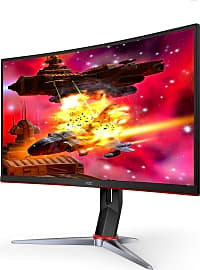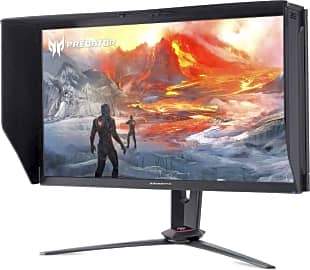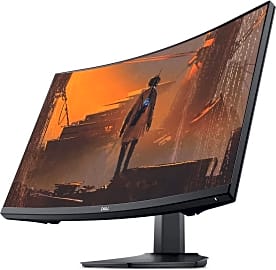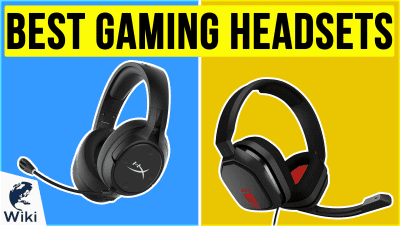The 10 Best Gaming Monitors

This wiki has been updated 28 times since it was first published in July of 2018. Even the fastest processor and the beefiest GPU are no good without the right screen to display the fruits of their computations. Gaming monitors are differentiated from standard displays (and TVs) by their super-low response times, minimal input lag, and frame-rate syncing capabilities. We've gathered the best options for taking full advantage of a PC or console at a range of prices. When users buy our independently chosen editorial selections, we may earn commissions to help fund the Wiki.
Editor's Notes
January 15, 2021:
In 2021, a couple things are almost necessities when choosing a gaming monitor. Variable refresh rates, in the form of either FreeSync or G-Sync, are so ubiquitous, that you'd be doing yourself a disservice to select a monitor without either. Secondly, input lag is as important to casual as it is to dedicated gamers. All of our selections have variable refresh rates, and they all have minimal input lag, as well.
We wanted to revisit this wiki briefly, with a focus on monitors that the average human being can actually afford - as in, monitors that won't cost more than a pair of high-end graphics cards. Luckily, there are plenty of high-quality displays that don't cost a fortune. The Samsung Odyssey G5 and significantly faster G7 are among the top choices not just because of their panel quality and curvature, but also because of their mid-level price. The Asus ROG Strix XG43VQ is an excellent and reasonably priced ultrawide, while the Alienware AW3420DW is its high-competition.
If you're extremely competitive, you'll like the high refresh rates of the Asus TUF VG279QM. Overall, we really like the LG Ultragear GL850 because of its pixel density and impressive color volume, and the AOC CQ32G2S due to its impressive price-to-performance ratio.
September 25, 2020:
With most of the major manufacturers in this category coming out with new and improved models since we last visited it, we all but completely overhauled the list. The only holdout was the compact, but capable LG 32GK650F-B, which keeps lots of top tier features, but scales them down to a 32-inch 1080p model to prevent it from getting too pricey.
There's a fair amount of crossover between this list and our list of curved gaming monitors, which makes sense given their ability to use gamers' peripheral vision to create an immersive experience. If you opt for one of the large, 49-inch options like the Acer EI491CR or the Samsung CRG9, it'd be wise to keep a couple things in mind. Not every game can adapt its environment to that native aspect ratio, and not every gaming space can accommodate such a behemoth. Take measurements just to be sure.
Also, anyone spending way too much time gaming might want to look for a model with eye-care technology like you see in the BenQ EW3280U 4K. This will cut down on blue light emissions and either reduce or eliminate the flickering of your backlight, which will help reduce eye fatigue and keep you gaming more comfortably for longer.
June 03, 2019:
High-end monitor technology is at a minor plateau right now, limited somewhat by the bandwidth of the DisplayPort 1.4 specification as well as the output of modern GPUs. For the average gamer, this means that there are more highly refined and well-tested displays on the market than pretty much ever before. The Acer Predator X34 occupies what many enthusiasts consider the sweet spot for gaming. It sits at 1440p with a high refresh rate and is ideally paired with a GPU equivalent to the GTX 1070 or faster. Acer also offers a 38-inch curved model, though it will require a little more processing power, and at its size, it helps to have a video card that supports DLSS (if you're into games with DLSS, of course).
You'll notice a handful of Asus monitors on the list. This is no accident. They've long been on the cutting edge of display technology, as evidence by the PG27UQ, which pumps out 4K video at incredible rates, and absolutely calls for a high-end RTX display adapter. But the Strix XG family, particularly the 32-inch version, is a quite well-priced group of monitors that nearly any gamer will be satisfied with.
And no discussion of enthusiast-grade screens would be complete without mentioning BenQ. We've included a 240-hertz 1080p option ideal for hardcore multiplayer fanatics as well as a pair of reasonably priced 4K units. Some of BenQ's options are so well-made that they're satisfactory for photo and video editing thanks to their incredibly accurate color reproduction. And Dell, certainly no stranger to making excellent displays, is always a good choice with their Alienware line.
Finally, take note that Nvidia is in the process of opening up their adaptive refresh rate technology to work with AMD FreeSync monitors. You'll want to make sure to update your monitor's firmware and your display drivers, and do a couple searches for the monitor that you're interested in, to make sure it works well in the FPS ranges you plan to play in. But we've vetted the monitors on our list, and the majority have at least decent G-Sync compatibility.
Special Honors
Nvidia Big Format Gaming Display They're big. They're bright. They're high-resolution. Did we mention they're big? Nvidia's most recent crop of technological marvels is slowly emerging, and hard to get your hands on, but if you have extremely deep pockets they're basically the holy grail of gaming monitors. Where televisions of the same size have average-to-poor pixel response times and input lag levels, these gigantic panels suffer from minimal motion blur and react almost instantly to your commands. Be prepared to shell out a lot of cash, though. nvidia.com















